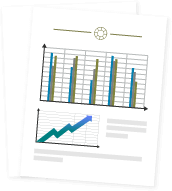Measuring the ROI on Your Website

When it comes to marketing for catering companies and small businesses, there are many commonalities across the board.
Over the years, we’ve found that these have been your marketing goals (as they frequently have been our marketing goals for you, too):
- Increase in brand awareness
- Growth in brand engagement/interaction
- Increase in qualified leads
- Growth in revenue and sales
In fact, all of these match the goals that most marketers have in general for their companies and clients—not just catering companies.
Obviously, as marketing goals, they should all drive your marketing efforts. However, it’s sometimes difficult to determine if your specific efforts are contributing to your results or not.
In other words, how can you tell if what you’re doing is actually working?
Throughout this article, we are going to walk you through some of our favorite tools to measure your return on marketing investment—specifically your website.
You will find ways to calculate your return on website investment, or your website’s value. However, we would like to point out that, as with many marketing tools, there is no perfect way to measure the value of a website, because in reality, it really does much more than what this calculator determines. (Your website is key in building and promoting your brand identity.)
The first two goals listed above certainly are heavily impacted by your website’s design, navigation, messaging, etc., but those goals aren’t easily traceable. Please keep in mind that if your website is outdated, or inefficient, or does not accurately reflect your brand identity, then it will probably negatively impact your first two (perhaps most important baseline) goals.
Measuring Return on Website Investment
Now that we prepared you on what you can expect to find in this article, below are the five numbers you’ll need to determine your current website’s ROI.
- Website traffic
- Website conversions
- Closing ratio on website leads
- Average catering sale (in dollars)
- Profit per event
Don’t worry if some of these numbers sound scary or difficult to find. We will help you find all of this information.
For this step, it’s simple to find this number by accessing your Google Analytics account.
We suggest calculating your average monthly number of visitors by adjusting the dates of the analytics based on how long you have had your website.
For example, if you launched on March 1, 2013, take the statistics from March 1, 2013, through March 1, 2015. For these 24 months average out the traffic per month with this calculation:
Total Visitors / Total Months = Monthly Traffic

Calls to action, in this case, would include things such as:
- Contact form submissions
- Live chat conversations
- Emails
- Phone calls
- Menu downloads
There are no formulas to determine this number; it’s simple addition using the information you would collect via your catering software (i.e., Caterease) or sales/marketing team.

BONUS TIP:
As a side note and something of which you should be aware, the average web conversion rates amongst all industries are two to five percent.
To help you determine where your website stands in comparison to others, we suggest using this formula:
(Conversions per Month) / (Monthly Website Visitors) = Conversion Rate
If your conversion rate is in the upper tier of that two to five percent, your website is doing a good job converting visitors into leads. Where you might want to look for growth, then, is through generating traffic so that you can increase those leads (a higher amount of visitors with the same conversion rate means more leads!).

The next step is to determine your closing ratio on website leads. How many sales inquiries do you turn into actual sales? Find out using this formula:
[(Total Signed Contracts) / (Total Proposals)] = Closing Ratio

Now, take your closing ratio and complete this calculation:
(Website Leads per Month) x (Closing Ratio) = Number of Website-Generated Events per Month


The next bit of information can also be found within your own team, or via your catering software.
Simply complete this formula:
Total Number of Sales / Total Number of Events = Average Sale


The final piece of information to determine your return on website investment is to quantify the profit on your average catering job/event (including food, labor, transportation, outside rentals, services and venue fees, etc.).
Now, conduct this simple formula:
(Avg. Catering Sale) – (Avg. COGS) = Gross Profit per Event

Now you have everything you need to determine your website’s ROI.
All it takes is just a bit more math, we promise.
Take step three’s number (Website-Generated Events per Month) and multiple it by step five’s number (Profit per Event) to determine the total profit you can expect from your website each month.

Our example shows us that Company A’s website should bring in $10,000 in new business each month.
If it costs $30,000 to build Company A’s website, and the above targets are met each month, then in just three months, Company A will experience a full return on its investment, and everything from there will be sheer profit!
Before we finish, we certainly have a disclaimer (which deals with average profit per event):
*Companies don’t always use the same numbers when calculating ROI. Often times, companies are only concerned about covering variable expenses; therefore use gross profit (as we have used in the example). Other companies believe all expenses should be considered (and covered) when calculating; therefore use net profit. If you would rather use net profit, simple substitute the numbers in step five.
The moral of the story:
Does your website rank well? Is it well-optimized and fully functional based on your target markets, geographical region, brand, etc.?
Now that you have your calculations and numbers, you should be able to see where a really dynamite website will not only pay for itself, but where it will really help drive in the hard numbers.
If you already have a dynamite website, then your marketing plan should involve tactics that help drive up those very first numbers we discovered: website traffic. That number is the beginning of all of these calculations and directly affects the outcome of your final number: $$ you get from your website each month.
Think about where you are in your website’s life cycle and determine where your marketing resources are best spent. As usual, we are always here to help!





